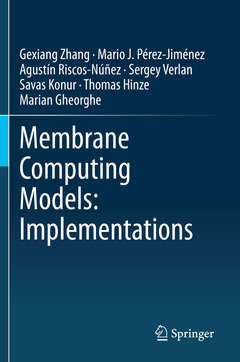Description
Membrane Computing Models: Implementations, 1st ed. 2021
Authors: Zhang Gexiang, Pérez-Jiménez Mario J., Riscos-Núñez Agustín, Verlan Sergey, Konur Savas, Hinze Thomas, Gheorghe Marian
Language: English
Subjects for Membrane Computing Models: Implementations:
Keywords
Membrane computing; P system; P-Lingua; MeCoSim; CUDA; FPGA; robots; ecosystem modelling; Infobiotics; bioinformatics
179.34 €
In Print (Delivery period: 15 days).
Add to cartPublication date: 07-2022
279 p. · 15.5x23.5 cm · Paperback
179.34 €
In Print (Delivery period: 15 days).
Add to cartPublication date: 07-2021
Support: Print on demand
Description
/li>Contents
/li>Biography
/li>Comment
/li>
Chapter 1 Introduction
1.1 General introduction of P systems implementation
1.2 Challenging problems of P systems implementation
1.3 Review of software implementations
1.4 Review of hardware implementations
1.5 Other implementation platforms
Chapter 2 P systems Implementation on P-Lingua framework
2.1 Overview
2.2 P-Lingua language for P systems variants
2.3 Simulation algorithms2.4 MeCoSim
Chapter 3 Software implementation for P systems
3.1 Automatic design of cell-like P systems with P-Lingua
3.2 Automatic design of spiking neural P systems with P-Lingua3.3 Modelling real ecosystems with MeCoSim
3.4 Robot motion planning
Chapter 4 Infobiotics Workbench - In Silico Software Suite for Computational Biology
4.1 Introduction4.2 Stochastic P Systems
4.3 Software Description
4.3.1 Modelling
4.3.2 Simulation
4.3.3 Verification
4.3.4 Parameter Optimization
4.4 Case Studies
4.5 Next Generation Infobiotics
4.5.1 Prediction-based stochastic simulations
4.5.2 High-performance simulation and verification
4.5.3 Biocompilation
4.6 Conclusions and discussions
Chapter 5 Molecular Physics and Chemistry in Membranes: The Java Environment for Nature-inspired Approaches (JENA)
5.1 Motivation and Introduction
5.2 JENA at a Glance
5.3 JENA Descriptive Capacity
5.4 JENA Source Code Design
5.5 Selection of JENA Case Studies
Chapter 6 P systems Implementation on CUDA
6.1 Overview
6.2 Specific simulations6.3 Generic simulations
6.4 Adaptative simulations
Chapter 7 P systems Implementation on FPGA
7.1 Introduction
7.2 FPGA Hardware
7.3 Generalized Numerical P systems (GNPS)
7.4 Implementing GNPS on FPGA
7.5 FPGA implementations of other models of P systems
7.6 Discussion
Chapter 8 Hardware implementations and applications
8.1 Knapsack problems with CUDA implementation
8.2 Robot membrane controllers with FPGA implementation
8.3 Robot path planning with FPGA implementation
8.4 Image processing with FPGA implementation
Gexiang Zhang
Professor at School of Control Engineering at Chengdu University of Information Technology, Chengdu, China. The President of the International Membrane Computing Society (IMCS), IET Fellow, IEEE Senior Member. Managing Editor of Journal of Membrane Computing (Springer) and Editorial Board member of International Journal of Parallel, Emergent and Distributed Systems. He is the main investigator of 5 scientific research projects funded by National Natural Science Foundation of China and of more than 20 scientific research projects at the national and provincial levels. He is the winner of the Grigore Moisil Prize of the Romanian Academy in 2019 and was awarded Sichuan Provincial Natural Science Award or Science and Technology Progress Awards in three consecutive years 2017-2019. Research areas include membrane computing, artificial intelligence, robotics, power systems, and their interactions. Author/co-author of more than 200 publications, two monographs, and (lead) guest editor/co-editor of more than 10 volumes/proceedings. He has more than 3800 citations with an H index of 34, according to Google Scholar.
Mario J. Pérez-Jiménez
Full Professor at the Department of Computer Science and Artificial Intelligence at Universidad de Sevilla, Spain, since 2009, and currently Emeritus Professor. From 2005 to 2007 he was a Guest Professor of the Huazhong University of Science and Technology, Wuhan, China. He is a numerary member of the Academia Europaea (The Academy of Europe) in the Section of Informatics. His main research interests include theory of computation, computational complexity theory, natural computing (DNA computing and membrane computing), bioinformatics and computational modelling for complex systems. He has published 19 books in computer science and mathematics, and over 300 scientific papers in international journals (collaborating with researchers worldwide
Presents comprehensive descriptions of the most significant membrane computing tools developed for various models
Describes the most relevant applications, facilitating a better understanding of how the tools are used in building, experimenting with and analysing membrane computing models of complex problems arising in robotics, automatic design of P systems, image processing, ecosystem modelling, systems and synthetic biology, and bioinformatics
Discusses efficient software and hardware solutions, together with the algorithms and platforms used



